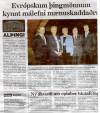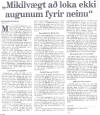1)
SCI
Issues
Introduced to European Parliament
2)
European Parliament
Vice President Miroslav Ouzký
Supports SCI Project
3)
The Icelandic
delegation’s proposal on spinal cord injury is approved by the Nordic
Council Welfare Committee.

1)
Issues of
Spinal Cord Injury Introduced to European Parliament
Adapted and translated from an
article appearing in the February 8, 2006 Moggi by Ólafur Thóroddsen.
At the January meeting of the
Council of Europe (COE), Strasbourg, France, the Icelandic delegation
hosted a meeting in the Council’s Palace of Europe to introd uce
the joint effort of Icelandic Health Authorities and the World Health
Organization (WHO) for spinal cord injury (SCI).
uce
the joint effort of Icelandic Health Authorities and the World Health
Organization (WHO) for spinal cord injury (SCI).
Many European parliamentarians,
officials, and diplomats attended the meeting, which featured the
documentary You Will Never Walk Again. The film calls for
integrating the diverse knowledge of SCI professionals throughout the
world and information on the treatment of people who have suffered SCI. An
international data base is being created, which will gather information on
SCI therapies for both professionals and the general public.
At the meeting, Birgir Armannsson,
the Icelandic delegation’s chairman, summarized the project and its
status. He thanked Audur Gudjonsdottir O.R. nurse for her unselfish
10-year commitment to this area and being an advocate on behalf of those
with SCI. Because many people have sustained this devastating disorder,
Birgir stated that it was important to collect information on better
treatments. Audur indicated that advances in treating SCI have progressed
slowly over the past half century, and believes the time had come to turn
this situation around and rally people for progress.
The meeting was called on the
initiative of Audur Gudjonsdottir and the Icelandic delegation and held in
cooperation with the Icelandic Health Department, the central office of
the Parliament of Iceland, and representatives of the Icelandic Foreign
Service. The meeting’s Icelandic delegation included parliamentarians
Birgir Armannsson, Birkir Jon Jonsson, and Margret Frimannsdottir.
The COE’s mission is to be a
guardian of the objectives of the member nations for human rights and
democracy, and to support economic and social progress. The COE meets four
times a year and includes representatives from 46 member nations.
Photo (Click on Thumbnail).
From left: Birgir Armannsson MP, chairman, COE Icelandic delegation; Audur
Gudjonsdottir, O.R. nurse; Margret Frimannsdottir MP; Hordur H. Bjarnason,
ambassador; and Birkir Jon Jonsson MP.

2)Important Not to Close Your
Eyes to Anything
Bergur Ebbi Benediktsson,
Morgunbladid
Miroslav Ouzký, a Czech
rehabilitation doctor, is a member and one of 14 vice presidents of the
European Parliament. He is visiting Iceland to learn about the country’s
project for spinal cord injury (SCI), including its educational database,
operating under the sponsorship of Icelandic Health Authorities and the
World Health Organization (WHO).
“I think this database is a
very sound project because the most seminal thing in this regard is to
expand dialogue on the treatment of spinal cord injury,” says Miroslav.
Audur Gudjonsdottir, OR Nurse,
has been pivotal in database establishment, as well as a long-time
advocate for additional SCI research. This reporter met the Czech
parliamentarian at Audur´s home with his wife, Zora Ouiska, a
child-neurology specialist, and Lara Margret Ragnarsdottir, an
ex-Icelandic parliament member, who has also been an ongoing SCI advocate.
his wife, Zora Ouiska, a
child-neurology specialist, and Lara Margret Ragnarsdottir, an
ex-Icelandic parliament member, who has also been an ongoing SCI advocate.
The Project Introduced to
the European Union
Earlier this year, Audur´s
database was introduced to the Council of Europe in Strasbourg, which had
been in the possession of a report on spinal cord injury composed by
Miroslav. In the ensuing Council of Europe discussions, all 46 member
nations passed a resolution stating their will to further support research
on spinal cord injury. The database thus enjoys Council of Europe support,
and now the time has come to acquaint the European Union with this
project.
“As a member of the European
parliament, I am a member of the committee on public health to which I
have introduced my report on spinal cord injury, and the proposals based
thereon that have already been passed by the Council of Europe,” says
Miroslav and explains that by this, he will bring in sharper focus to the
25 member nations of the European Union what they already have passed in
the Council of Europe.
“By this I want to bolster up
discussions within the EU on spinal cord injury and consequently that
funding will be increased in this facility and eventually that EU will
prepare legislation on these matters. My report states among other things
that it is vital to seek new methods in the treatment of spinal cord
injury. This is the same as is emphasized in the database which embodies
all known methods of treatments of spinal cord injury without any
prejudices.”
Research is Investment
“If I mention unorthodox
medicine such as applied by Dr. Zhang to my Czech colleagues they contend
that this is simply some Chinese talisman. It is, however, important not
to close your eyes to anything,” says Miroslav and points out that Western
methods of treatment are indeed in many cases highly effective but on the
other hand that research and treatments in this department have almost
remained the same for the last fifty years.
“In my report I call this the
blind circle because it is sometimes as if people run blindly in circles
without looking for their final goal. It is also possible to view this
through the lenses of economics. It must be a financial vantage point to
invest in research that will enable paralyzed people to get on their feet.
It is expensive to take care of those who are unable to do so themselves,”
says Miroslav, who adds that people have almost ceased to regard research
on spinal cord injury as an option of progress.
The Situation is Like an
Epidemic
“I often compare this to the
bird flu. Imagine all the money that is being spent on researching the
flu, a disease that has lead to the death of 120 people. People put all at
stake to stop the flu spreading out but we have a malady like spinal cord
injury where nobody is longer interesting in doing new research. We want
to change this attitude,” says Miroslav, who adds the comparison between
the bird flu and spinal cord injury is not totally irrelevant since the
cases of spinal cord injury are constantly on the rise, and thus it can be
compared to an epidemic.
“People suffer spinal cord
injury in all kinds of accidents but the accidents are not necessarily
growing in numbers. Medical science is constantly in progress so that
people now live longer after these accidents than before,” says Miroslav,
outlining why there are more and more people with spinal cord injury.
Asked if there is also in the
wings an option to decrease accidents causing spinal cord injury, Miroslav
consents to that “Yes, that is highly possible. In Australia for instance
an effort was implemented to prevent accidents causing spinal cord injury.
An example of this is when people dive into too shallow swimming pools,
and this effort rendered good results, “says Miroslav, who articulates his
worries about the many accidents in sports leading to spinal cord injury.
“Several kinds of peripheral
sports are gaining in popularity, but these sports often contain high
risks of causing spinal cord injuries. People also can suffer these
accidents in many kinds of activities. In the United States, many suffer
accidents playing football - horse riding can be very dangerous as people
know in Christopher Reeve´s instance - and in Central Europe, one
constantly hears about persons breaking their necks falling from walnut
trees,” says Miroslav relating that the picking of walnuts is quite common
in his country and the neighboring countries.
Those with Spinal Cord
Injury Need to be More Visible
Finally, Miroslav stresses the
importance of not forgetting those who have sustained a spinal cord
injury. He says that immediately after the accident everything is done to
keep people alive, but then we tend to forget that they live for decades,
often restricted to a wheelchair.
“People with spinal cord injury
are not visible enough, and therefore we are not attentive enough to these
matters. In my country we have, however, a forceful spokesman for those
with spinal cord injury. It is a man who was one of the leaders of the
flannel revolution in 1989. He was a young actor at the time and was badly
hurt in an automobile accident after having spoken at many exhortatory
rallies,” says Miroslav.
A Lot of Work Ahead
“I do not expect a miracle,
which would not be a responsible attitude. We are now standing at the
beginning of a certain road, and ahead there is huge work in research on
spinal cord injury,” says Miroslav, who rejoices at the efforts of Audur
Gudjonsdottir and the database that has been established in Iceland.
“My work at the European Union
will among other things focus on increased access to the database, to
publicize it, and possibly to facilitate financial support,” says Miroslav
at the end of our talk.

3)
The Icelandic delegation’s proposal on
spinal cord injury is approved by the Nordic Council Welfare Committee.
(January 2011)
On Wednesday, the Nordic Council
Welfare Committee approved the Icelandic delegation’s proposal for
co-ordinated information on spinal cord injuries in the Nordic region.
The proposal recommends the
appointment of a committee of scientists and physicians to collect
information and prepare an overview of Nordic and other research and
treatment of spinal cord injury, in the form a report, and to prepare
proposals for improvements in the research and treatment of spinal cord
injuries.
Approval was also given to a
proposal to investigate the extent to which people with spinal cord
injuries are active in the employment market and to embark on the
creation of a Nordic quality file on spinal cord injuries.
Approximately 1000 Nordic
citizens suffer spinal cord injuries every year. Progress in the
treatment of spinal cord injuries has been much slower in recent decades
than in other fields of medicine, such as in cancer, cardiovascular and
ophthalmological treatment.
As a result of the Welfare
Committee’s approval, the proposal will now be submitted for discussion
at the annual Session of the Nordic Council in Copenhagen in November.
The Nordic Council was formed in
1952. The Council has 87 elected members from Denmark, Finland, Iceland,
Norway and Sweden as well as from the three autonomous territories: the
Faroe Islands, Greenland and Ĺland.
TOP